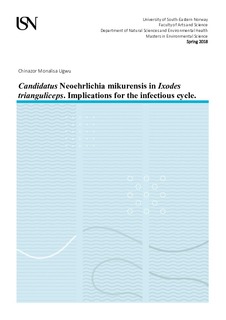| dc.contributor.author | Ugwu, Chinazor Monalisa | |
| dc.date.accessioned | 2019-02-11T12:53:55Z | |
| dc.date.available | 2019-02-11T12:53:55Z | |
| dc.date.issued | 2018 | |
| dc.identifier.uri | http://hdl.handle.net/11250/2584797 | |
| dc.description.abstract | Ticks and its pathogen constitute a growing burden for animal and human health in the world. Ticks are blood-feeding parasites, which make them capable of transmitting various pathogens to their hosts that can cause tick-borne infections and tick-borne diseases. These infections and diseases affect wild and domestic animals. The aim of this study was to investigate the presence of the tick-borne pathogen, Candidatus Neoehrlichia mikurensis (CNM) in Ixodes trianguliceps and its possible role in the infectious cycle. It is an emerging pathogen in Europe. This is the first study of CNM in Ixodes trianguliceps in Norway and the first study showing the presence of CNM in Sorex araneus. CNM has been described from previous studies in hard tick Ixodes ricinus and small mammals as well as in cases of human disease. Ticks were collected from trapped rodents and shrews in 2015 and 2017 along two mountain transects. Spleen samples of 46 small mammals and 116 attached Ixodes trianguliceps were investigated by using a real-time PCR to determine the DNA of CNM. Altogether 72% of the spleen samples of the small mammals were positive for the DNA of CNM. Most of the infected small mammals were Myodes glareolus (Bank voles) and Sorex araneus (common shrew). Altogether 81% of Ixodes trianguliceps were positive for DNA of CNM. There was high infection rate of CNM in infected Ixodes trianguliceps collected from infected small mammals. However, there were Ixodes trianguliceps including larvae, nymphs and adult that were infected although their host animals tested negative for the DNA of Candidatus Neoehrlichia mikurensis. Of 15 samples sequenced, 8 samples gave readable sequence, and all of which were confirmed as CNM. There seems to be evidence of transovarial transmission of CNM in Ixodes trianguliceps in this study. Although Ixodes trianguliceps does not bite humans, it may indirectly be of medical and veterinary importance of its role as a maintenance vector of CNM among small mammals. | nb_NO |
| dc.language.iso | eng | nb_NO |
| dc.publisher | University of South-Eastern Norway | nb_NO |
| dc.subject | ticks | nb_NO |
| dc.subject | tick-borne diseases | nb_NO |
| dc.title | Candidatus Neoehrlichia mikurensis in Ixodes trianguliceps. Implications for the infectious cycle | nb_NO |
| dc.type | Master thesis | nb_NO |
| dc.description.version | publishedVersion | nb_NO |
| dc.rights.holder | Copyright The Author | nb_NO |
| dc.subject.nsi | VDP::Mathematics and natural science: 400::Zoology and botany: 480::Ecology: 488 | nb_NO |
| dc.subject.nsi | VDP::Mathematics and natural science: 400::Basic biosciences: 470::General microbiology: 472 | nb_NO |
